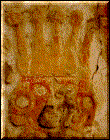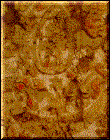


The archaeological place is located in the right riverbank of the valley
Chicama, next to the coast, Magdalena of Cao district, Ascope province, in the
deparment of La Libertad. To some 60 minutes of the city of Trujillo, they are
the adobe pyramids known as "El Brujo" they lock in their interior more than 4,500 years.
The archaeological complex is constituted by the Huaca Prieta in the south end,
the huaca Cao Viejo and the huaca El Brujo they are the most prominent
structures in the place, where it also exists an important smaller number of
mounds, cemeteries and domestic areas of diverse periods spred out on a geologic
platform in a triangular way, which has an approximate extension of 1.2 km2,
surrounded by the north, south and this with small lagoons and cultivation
lands, and for the west with the spa of Prieta tip and the beach El Brujo.
 From August of 1990 one comes executing one of the projects of archaeological
investigation but importants of the Peruvian north of the last 20 years,
inside a program of medium and I release term in which it intervenes the
National University of Trujillo, the National Institute of Culture of La
Libertad, and the Foundation Augusto N. Wiese with financial help.
From August of 1990 one comes executing one of the projects of archaeological
investigation but importants of the Peruvian north of the last 20 years,
inside a program of medium and I release term in which it intervenes the
National University of Trujillo, the National Institute of Culture of La
Libertad, and the Foundation Augusto N. Wiese with financial help. This place has been busy from the Archaic one with huaca Prieta (2,500 a.C) with
an occupation continuos until the arrival of the Spaniards where a church was
erected been founded by the Dominicos' priest next to an important population of
the well-known time as Cao. During the occupation Moche (0 - 650 D.C.) the
complex had completed the most important function as progressive axis
consecrated to activities urban ceremonials for the elites and more important
deities in this valley.
 The more big of the architecture in the huaca Old Cao is the impressive
polichrome reliefs, in which it has been represented or pictures in panels with
naked characters tied by the neck with a rope, well-known as "prisoners" those
that advance from West to this; behind them several warriors continue carrying
their weapons. In this same level, in the corner nor-this of the building is a
relicto totally decoration, in two of their facades, with reliefs polícromos
representing four panels with six couples of warriors in small scale; in their
main facade the well-known panel as the topic complex 1 and 2 shows the
cosmovisión of the world Moche, unknown until the moment in other big ceremonial
centers of this time.
The more big of the architecture in the huaca Old Cao is the impressive
polichrome reliefs, in which it has been represented or pictures in panels with
naked characters tied by the neck with a rope, well-known as "prisoners" those
that advance from West to this; behind them several warriors continue carrying
their weapons. In this same level, in the corner nor-this of the building is a
relicto totally decoration, in two of their facades, with reliefs polícromos
representing four panels with six couples of warriors in small scale; in their
main facade the well-known panel as the topic complex 1 and 2 shows the
cosmovisión of the world Moche, unknown until the moment in other big ceremonial
centers of this time. Others of the represented topics correspond to a series of taken characters of
the hand in front position and rigid those that decoran the second level,
it has been represented with the same technique of low relief to the degollador
or also"Ai Apaec" human character superior half and the inferior part
with body and spider foot. All this corresponds to the last phase of occupation
of the building, when the inopportune abandonment continued by torrential rains
that destroyed its decorated adornments partially happened.
The whole building has the form of a staggered pyramid it truncates square with
100 m. of base and approximately 30 m. height. The building is guided toward
the North.
Recently the spectacular discovery of a monumental wooden idol was made, carved
in an old trunk of Lúcumo of approximately 2.50 m. of high for 90 cm. of
diameter. Probably correspond to a deity Moche of the early phases that was
discarded or changed to have been infested with termites and black-beetles
that deteriorated him strongly.
The whole complex archaeological guard a lot of information for the different
cultural periods of the Peruvian north coast, besides their tourist potential
that will be good for the economic and social development of this region and
their near towns.
 Home Page
Home Page
 Indice
Retornar
Indice
Retornar
